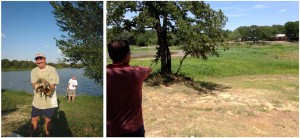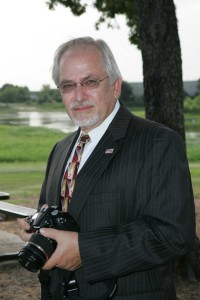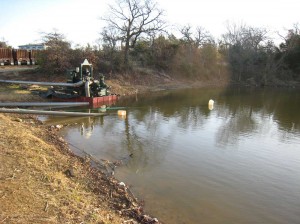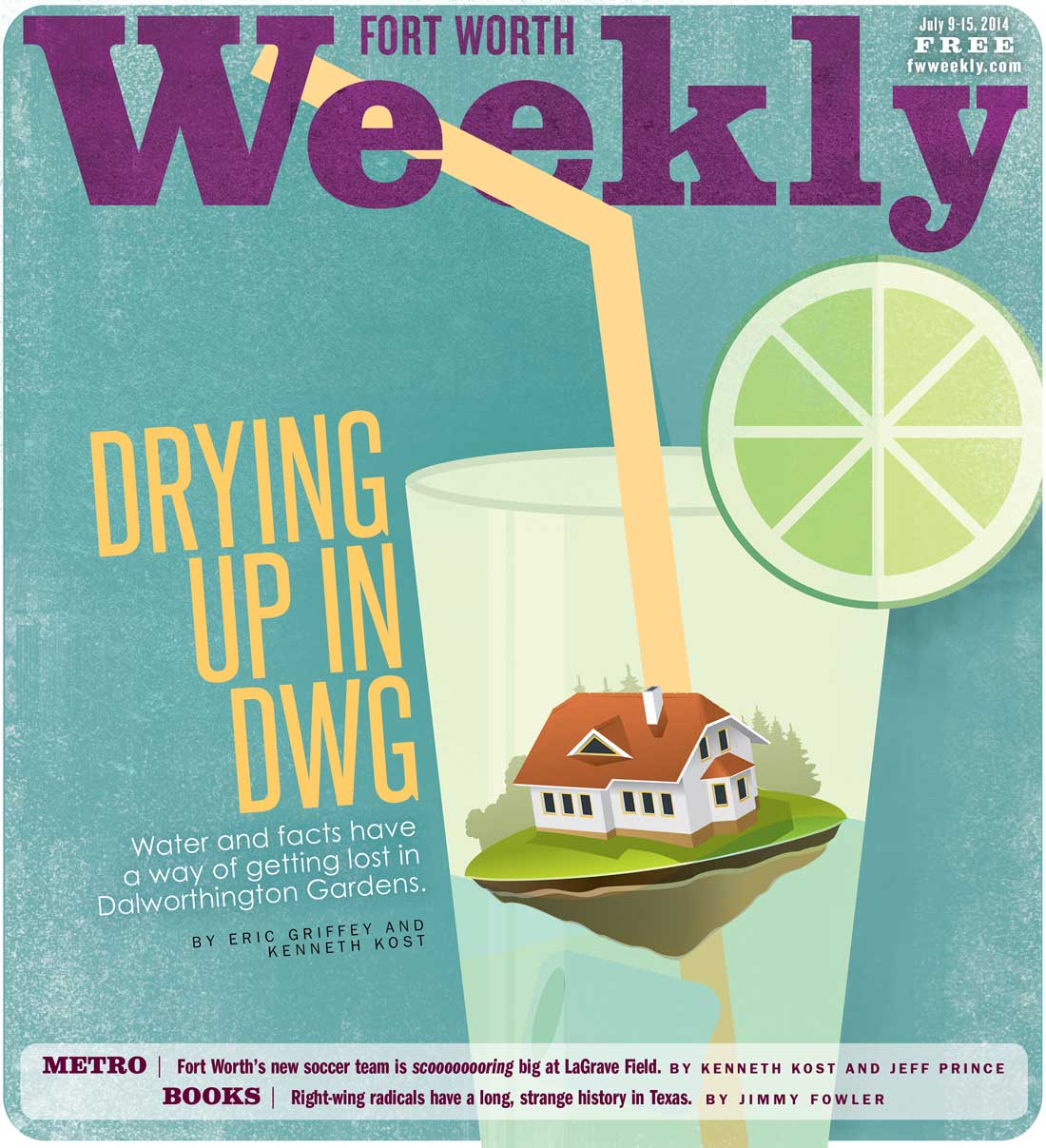As Steve Flowers walked along what used to be the shoreline of Pappy Elkins Lake in Dalworthington Gardens, he became sentimental.
“That’s where I taught my son to fish,” he said, pointing to a tree standing in what looked like an overgrown pasture. He watched a dog chase a ball across what used to be part of the lake.
The New Jersey native owns and operates his own small business. He moved to the neighborhood in 1991, drawn by the small-town atmosphere and picturesque lake.
“It’s a close-knit community,” he said. “Dalworthington Gardens is a unique town. You have shacks and you have half-million-dollar homes on the same block.”
The lake was formed in the 1960s when quarry workers hit a natural spring and their pit filled with water. The accidental lake became one of the city’s defining features. There’s a picture of it on the homepage of the city’s website.
In the last four years, however, the four-acre body of water has been reduced almost to a puddle.
Drought has taken its toll all across Texas, and many lakes have experienced record or near-record low water levels. But a small group of concerned citizens in Dalworthington Gardens believes that low levels at Pappy Elkins are due to something beyond the lack of rain.
The data they gathered led them to conclude that gas drillers may have taken more water than allowed by state permit, helped along by the town’s mayor and other officials. Mayor Michael Tedder at one point wrote a letter giving drillers permission to take water from the lake before the city council had approved that action — and without the approval of the state agency that controls such water removals.
The upset residents, who call themselves the Pappy Elkins Restoration Group, also say that XTO Energy, owner of the well site on the shore of the lake, has broken city ordinances and state regulations in drilling a total of 11 gas wells there over the past six years. Their questions have city officials squirming and state officials inspecting. XTO Energy officials are apologizing and promising to do better on some counts, while declining to answer many questions and denying allegations that they took more water from the lake than allowed.

Most outsiders know Dalworthington Gardens only as a speed trap along Pioneer Parkway in southeast Tarrant County. Now, however, the town of about 2,300 people may be joining the not very exclusive club of Texas municipalities where the dangerous downside of urban gas drilling is affecting residents’ health, local politics, city budgets, and the more and more contentious problem of threatened and dwindling water supplies.
The debate has divided the town. Some support PERG, while city officials and their advocates say the group is spreading misinformation.
Tedder and other city officials deny any wrongdoing. Tedder said that XTO has been responsible in its drilling, that neither the company nor the city has done anything “underhandedly or deceptively,” and that PERG has stirred up a hornet’s nest based on half-truths. “Some of the information that has been disseminated has been inaccurate,” he said.
The group is definitely intent on spreading information: Their yard signs are scattered throughout the neighborhood near the lake, encouraging people to visit their website, full of data that group members say are evidence of the city and energy company’s wrongdoing. Members have also taken their complaints to the Texas Commission on Environmental Quality.
Those complaints go beyond the critical but typical questions about urban drilling, such as worries about air pollution, noise, and water usage. Group members want to know why XTO was ever allowed to drill and hydraulically fracture (“frack”) the wells from a pad site that may be sitting atop or very near an earthen dam. The drilling site is next to an elementary school.
TCEQ officials told group members that they hadn’t known the dam existed, confirmed that the well pad is indeed sitting on a dam, and said they are doing further investigation. The U.S. Army Corps of Engineers, the nation’s premier dam builders, won’t allow gas drilling any closer to their dams than 3,000 feet.
But hard data have a way of slipping sideways in Dalworthington Gardens. The city, for instance, apparently isn’t completely sure about how the lake was formed. At least one resident says the pad site isn’t actually on a dam, but on a “water-containment” structure, and that what TCEQ really needs to be asking about is the access road XTO built across a creek, which he fears could cause flooding in the future. And a contract worker hired to inspect the gas well for the town told residents that he’d never done an inspection there — despite four years of drilling — because he’d been told nothing was going on at the site, where the company is now engaged in its third round of drilling and fracking. Recently, after a dust cloud from the site enveloped the neighborhood and left residents with irritated eyes and headaches, XTO responded by saying the activities at the site were being done correctly.
Flowers, who said he supports gas drilling when it is done correctly, is still 50-50 on whether or not he wants the gas drillers to stay in town.
“I know society needs this gas,” he said. “I want them to clean the site up, I want them to put the water back, we need our lake restored, put the dam intact, and make sure it is not leaking.
“No one from the city will give us a straight answer,” he said. “We thought they just took more water than what they said. This is what really jump-started us. We requested XTO come out and have a meeting. Nobody would come out.”
********
Pappy Elkins Lake is a small green eye in the heart of Dalworthington Gardens. City hall and the fire and police departments are next door, and most of the nearby homes are high-dollar real estate. Just north of the lake is a park and a baseball field — although the city has allowed XTO to take over the baseball field and build a giant water tank there. On the south side, only a few yards and a thin line of trees separate the elementary school from the entrance to the gas site.
The town gets its drinking water from Fort Worth via pipeline, so the lake was only recreational until XTO arrived. Various fishing websites have given it high marks for beauty and a large supply of worm-hungry fish. Now, not only is the lake a shadow of its former self, but the portion of its shoreline occupied by the gas plant is littered with tubes, hoses, tanks, and other equipment showing big rust stains. The cover of one wastewater tank has a gaping hole.
Resident Cyndi Noonan called Pappy Elkins “the treasure of Dalworthington Gardens.”

“It is an oasis in the middle of the Metroplex,” she said, “a small lake and park that was vibrant with wildlife. People come to fish and relax, ride horses, let their children feed the ducks and birds, exercise walking the circuit and lake, play ball on the field, swing the swings, or picnic.”
Now, she said, the way the city has dealt with the drillers has caused her to lose faith in her elected officials.
“I don’t trust that my best interest as a citizen of Dalworthington Gardens is being represented by this council and mayor,” she said.
In 2006 the city council passed a standard drilling ordinance that sets limits on noise, light, and emissions levels. It sets parameters for oversight by the city and requires general upkeep of the site.
The following year, XTO and other companies arrived to bid for drilling rights. Tedder promised to be a watchdog on behalf of his constituents.
“If they come into our city and try and do bad things, trust me, this city will do everything in its power to squash them,” he said at a public meeting that residents describe as being more like a pep rally. “We will stand up for what we think is right and what we think is appropriate.”
At that same meeting, XTO officials told citizens they would never use water out of Pappy Elkins. The drilling ordinance doesn’t speak to water sources, but XTO made that same promise when it got the mineral lease and signed a surface-use agreement with the city.
That didn’t stop the company, just a year later, from asking for lake water in the first drilling permit it requested from the city.
The permit was initially denied in May 2009. Despite that denial, however, Tedder wrote a letter giving TXO permission to use the lake water. Three weeks later, the council approved the permit and allowed XTO to take enough water for its first round of fracking and drilling, on the condition the company would eventually replace the water.
Residents were upset, because there had been nothing on the council’s agenda about using water from the lake.
XTO also needed permission from TCEQ to take the water. The state agency regulates water rights, which puts it in charge of temporary water-use permits. TCEQ granted the company a one-time permit to take 3.2 million gallons. That permit expired on Dec. 28, 2010.
Perhaps not surprisingly, XTO came back asking for more lake water. What happened next eventually got Tedder into hot water with residents.
This time with the city council’s approval, the mayor issued another letter of permission extending TCEQ’s drilling and water-use permit for three years, with no limits on how much water the company could take. But TCEQ turned down XTO’s request.
In December 2010, local residents photographed what appeared to be a phony water permit posted at the Dalworthington Gardens drill site. The document posted was actually a permit to take well water from Edwards Ranch for a drill site in Fort Worth.
Suann Lundsberg, a spokeswoman for XTO, denied that her company took more water from the lake than allowed.

“XTO received a permit from the TCEQ to withdraw water from the Pappy Elkins Lake,” she said. “XTO believes it withdrew no more water than it was allowed per the permit, which is 10 acre-feet [approximately 3.2 million gallons].”
She did not answer questions about why the company asked to use the water after promising not to. Nor did she respond to inquiries about the Edwards Ranch permit posted at the Dalworthington Gardens site.
Critics also don’t think the drilling company’s water-usage numbers line up with information from the city and TCEQ.
The energy company reported that it used 10.8 million gallons of water to frack three wells in 2010.
However, the town’s own records show it provided XTO with 2.7 million gallons from the lake and 4 million gallons from the city water supply, pumped out of hydrants. That comes to 6.7 million gallons. Where, the critics ask, did XTO get the remaining 4.1 million gallons?
Noonan, one of the more vocal critics of the city and the drillers, said she was told by an XTO staffer that the company had not measured how much water it had taken out of Pappy Elkins.
“[XTO official] Will Winston told us he could back into that number” by starting with the company’s figure for total water used and subtracting the amount the company bought from the city’s metered water supply, she said.
That would mean that, indeed, the extra 4.1 million gallons came from Pappy Elkins Lake. XTO “exceeded the permitted level” of lake water by that much, Noonan said.
Noonan also believes that XTO did not replenish the lake as promised. She said she was told by city officials that the energy company carried water back to the lake in tankers.
“I called the mayor and said, ‘We’re very concerned about the lake. It is going away,’ ” she said. “That day we had a realization of how low it actually was. A teenager walked [through the lake], and it didn’t reach his waist,” she said.
“Mayor Tedder said it would fill up when it rained. He said [XTO] replaced every bit of water they took out,” she said. “I was astonished by that. I asked how, and he said they trucked it in from an XTO water-treatment facility. That really raised my concern. I didn’t see any trucks.”
“Later, after researching, we realized it would take over a thousand tanker loads or something like that to fill it,” she said. “It never happened, and he immediately said it did. He got aggravated every time I talked about water. I started to investigate.
“We asked Winston where they got the water they trucked in, and he asked, ‘What water? We don’t normally do that, and I am not aware that we did that this time either,’ ” she said.
Noonan and others in the group also provided photographs showing that XTO’s pump was still in the lake during an active frack, long after their TCEQ permit had expired.
After months of denying that the pump had remained in the lake beyond the expiration of the state permit, XTO administrator Walter Dueease told citizens at a recent city council meeting that XTO was permitted to pump 3.2 million gallons out of the lake but had pumped only about 2.9 million gallons. He admitted the pump was in the lake after the expiration date but said that that didn’t mean the company was taking more water than allowed.
During a heated exchange between Noonan and Dueease after the meeting, the XTO executive refused to comment and hurried away from a reporter.
Tedder and other members of the council characterized the city’s relationship with XTO with phrases like “good neighbor,” and “responsible stewards.” The mayor attributed the lake’s low level strictly to “drought conditions and evaporation.”
“We were being lied to by the mayor,” said Noonan, after the meeting. “That is the reason for the [PERG] website. We decided we needed to raise community awareness.
“When you would tell people what [the mayor and council] would say, they can’t believe it,” she said.”
Noonan said the city has changed the rules for gas drillers at every step.
“We admittedly weren’t following it closely enough,” she said. “We were not really aware they were going to put more than 11 wells on that pad site. In our ignorance, we didn’t know what questions to ask.
“I was naive and believed my city government had my best interest at heart and would handle it,” she said. “I am no longer ignorant or naive.”
********













Sorry, no sale! The Pappy Elkins “lake” was never more than a 2-3 acre pond. In years past, it has been overrun with algae and pond scum, requiring regular remediation-dredging at tax payer expense ( many years before ANY drilling/fracking activities were initiated).. This was due to the close in neighborhood lawn maintenance and gardening nitrogen rich fertilization activities of the residents of DWG combined with post storm/flooding runoff pollution. Wild life? That’s also fairly overblown. There have been a number of varieties of urbanized ducks seen in any local park, squirrels and backyard birds, and really not much else. Fishing? For years there was a” no fishing” sign on the western side of the “lake” out of public health and safety concerns.because the “lake” was basically polluted. The DWG water supply has always been a bit suspicious with high iron basically turning outside house edifaces orange post regular lawn and garden watering.
You are incorrect Marcie. The lake was larger than what you say. We did have a foreign plant many years ago that needed to be extricated and to my knowledge the lake has never been dredged. I have lived on the lake 20 years and have NEVER SEEN pond scum. Also, the wildlife we had included blue heron, white heron, many varieties of turtles, many varieties of duck and geese, fox, beaver, hawks, split tails, bass (large and small), catfish, lake perch, just to name a few. The high iron content you talk about is in private wells not in the spring of the lake. Beauty is in the eye of the beholder, Marcie. We see great beauty in Pappy Elkins and our city. It’s definitely more beautiful than a rusted out pad site with sound barriers. I find the sounds of birds and ducks more beautiful than the clanking of trucks and pipes and alarms going off.
Marcie, Wondering if you are in fact a DWG citizen. Out of all the statements you made, I can agree with only one. Pappy Elkins was in fact a very small lake. However, most of everything else you said is simply not factual. I have been a citizen for 22 years and have watched our Pappy rise a few feet and fall a few feet on a regular basis due to weather related issues. The wildlife has always been abundant. So abundant, in fact, that those of us within a few blocks had excess ducks swimming in our pool, possums, raccoons and even armadillos running everywhere. They are gone. I won’t even discuss fishing…too sad, one of our citizens (now passed) put much money and effort into stocking the lake with fish approximately five years prior to the arrival of the drill site. It was his personal mission to have the children of DWG enjoy fishing. The fish were not able to survive the destruction of our Pappy! As Cyndi confirmed, we did have one foreign plant incident which gratefully our city dealt with, other than that, no major issues. Please understand, Marcie, this campaign is not about ending the XTO/DWG relationship, it’s about doing things the safe and correct way
Ms. Noonan is correct about the size of the Lake and the foreign plant that was introduced; non-native water hyacinth. Native lake vegetation, needed for a healthy lake and healthy fish population, never recovered like before the chemicals were used to wipe out the foreign invader chocking the lake. For this reason, some have referred to Pappy Elkins as a “dead lake”, but yes, there are still fish there. Regarding my quotes in this FW Weekly article: I cannot, and do not speak for the TCEQ, nor can I speak for the City of DWG. I am just an interested citizen in the DWG community; I live about 600 feet from the well site. My statement regarding the road and culverts blocking the drainage, and functioning as dam WAS QUESTION, NOT A STATEMENT!! The road and culverts only becomes a dam, or blockage to flow, if the culverts become clogged by a 100 year flood. The original surface of Lake Pappy Elkins covered 8 to 10 acres. The on-going drought in Texas, has over the past few years has evaporated the lake down to 4.9 acres, which is the size it was at the time this story was written for the FW Weekly. I measured the rain and runoff in DWG from June 22 to June 25, 2014: the lake’s surface area increased to 5.9 acres, and raised the lake 6.25 inches. That amounts to 2.4 acre-feet of rainwater and rain runoff, or about 924,000 gallons. In comparison, that’s half the amount of water XTO needed to frac their 5 new wells. (The DWG city website states XTO’s frac tank on the city’s ball park held 43,000 barrels, or about 1.8 million gallons.) It should be noted that although Lake Pappy Elkins is very low and shallow, it can only fill up about two additional feet! More rain and runoff than that and all excess water will flows down the Trinity River and on to the Gulf of Mexico. Our small lake can never get back to the level the people in our community want unless repair work is approved and done. The springs I mentioned in your article, DID NOT FORM THE LAKE, but the old quarrying would have stopped when their diggings filled with water. Springs were known to be present in the area before the quarrying began. Before DWG City Hall was built, there was actually an artesian well on the location. I don’t know the real answer as to what stopped the quarrying, but I can only guess. Perhaps ask the engineers who tried to lower Cooper Street separating UTA campus, just a few miles from here, and a few years ago. Original plan was to lower Cooper Street so cars could go under a planned, unobstructed campus walk way for the students.. excavation of Cooper Street had to stop due to hitting a ground water flow, they could go no deeper. A crossover bridge had to be built upward instead. Just food for thought.
I have indeed lived in DWG, though no longer. You folks have a bad habit of electing “mayors for life” and then you are surprised at the cronyism and other toxic effects of virtual dictatorship. Pappy Elkins was a fairly respectable little pond in past years–not really a” lake” by anyone’s definition. The ducks and local birds are still a lot of fun. I am pleased that Larry G is honest enough to admit that chemical treatment of the lake for the water hyacinth dealt it a considerable environmental blow
(which was many years ago as I recall–possibly a decade ago),from which it never really recovered. I live in the area currently and as far as we are concerned, there is never a shortage of possums, raccoons, armadillos,cottontails, skunks etc. Just start a vegetable garden or compost pit and find out. I understand your distress but over-exaggeration does not help the situation, and indeed makes you all look a little silly. Get some term limits going on your local elected officials if they treat you and your concerns unfairly and dismissively.
Isn’t this a man made lake rather than a naturally occurring body of water? And- as such -isn’t it particularly subject to the natural vicissitudes of neighborhood environmental pollution? DWG is a lovely community and has more to offer than Southlake or Grapevine, for example, IMO,but Marcie H. is correct. You folks have to get your act together and stop blaming the convenient “whipping boy” of the fracking /energy corporations. Take this concern locally and see what you can accomplish rather than depending upon dubious external state or natl. govt “services”… YOU CAN DO IT!
Snappy Pappy
Let’s lighten it up. That’s an Alligator Snapper Turtle I am holding that I caught and released back into Pappy 2008. In 2004 I observed one on the west roadway at least 5 times bigger; nobody believed me till I caught this one. Ft Worth zoo confirmed this is rare for them to be in our area and they are a threatened species. I have faith old legendary Snappy Pappy is still alive (they can live up to 125). He just needs more water!
Have you actually been to Pappy Elkins? We have lived in DWG for several years and I have photos of my kids playing at the lake with a wide variety of wildlife in background. If runoff from lawn care was the culprit then the lake would have had problems well before the well went in.
My children have attended The Montessori Academy just north of the lake since before the well started. We were apprehensive about the well going in so close to the school but unfortunately there wasn’t much that the parents could do about it. The noise and dust at the school from the well and the trucks going back and forth to the well at the school is horribly disruptive.
As a long-time resident I am appalled at the horrible job our elected officials have done at protecting our town. Since the wells went in I have voted against them because of this but it hasn’t done any good.
Much of the discussion in the commentary is regarding the invasive plant species-water hyacinth which required a lengthy toxic chemical eradication treatment many years ago –possibly a decade— from which the lake “never fully recovered” leaving some to designate it a “dead lake”. This was many years before the fracking industry wells were allowed in DWG. Please read the comment by Larry Galbiati who is cited in the article and corrects the author on a few points, The points some commenters/bloggers (who have lived in DWG-BTW) are making here is that the lake (in reality a pond) was fragile( and damaged?) before due to opportunistic vegetation and pollution poisoning.
We agree that it was irresponsible for the city elected officials to disregard the environment, and allow drilling to proceed, but blaming everything on the drilling companies is too simplistic.
I am 53 years old and have been coming to Pappy Elkins since I was 8. I caught my first fish in that lake. It has been reduced to nothing more than a mudhole. If you read the article and the research with an open mind and no agenda you will see that this has happened on our Mayors watch and with his approval. The lake and park have always been a tranquil peaceful getaway in a city being overrun with concrete and people. I believe in what this group of DWG citizens stand for and I support them.
Well…I guess you can stop arguing about if there are any fish in Pappy Elkins. You can go out there and count them as they float to the top of the water. There’s a major fish kill happening there now. Don’t worry about the birds. They’re all gone except the buzzards. Hopefully Snappy Pappy, the foxes, coons, armadillos and other wildlife escaped while they could. And to anyone that wants to dispute that XTO Energy and their fracking operation didn’t do this, do your research. They have admitted draining the lake for fracking with the City’s blessing. Ft Worth Weekly…..please do a follow up story to this one. Things have gone from bad to worse. Don’t except a statement from the City or Mayor. They’re hiding behind closed doors.
That’s the spirit! Continue to argue amongst yourselves over what a ‘lake’ is, the size, condition and whether or not it’s man made and ever had an algae problem. Let’s completely ignore the bad acts on the part of XTO as well as the mayor. (News flash: Anyone who actually uses the phrase ‘Good Neighbor’ and ‘responsible stewards’ when referring to Industry either works for Industry, is their spokesperson, or benefiting financially)
Who cares if XTO or the mayor did anything inappropriate or illegal or why the discrepancy of millions of gallons of water?